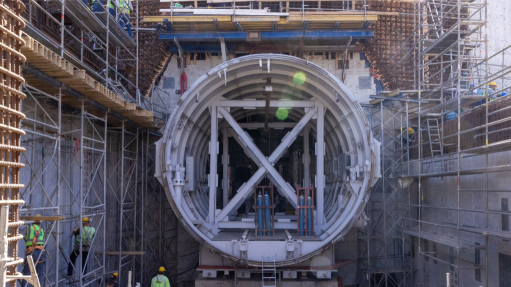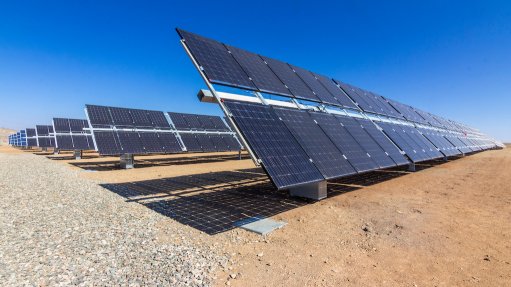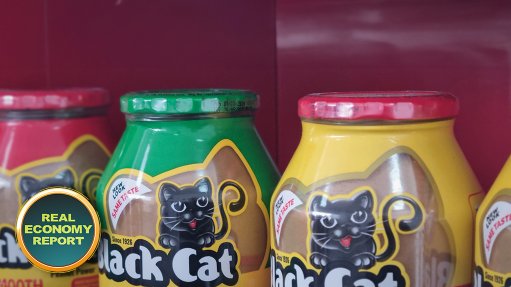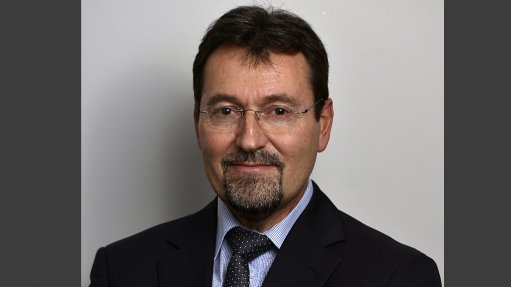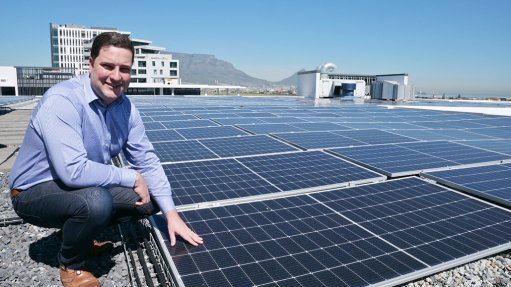3K tools with conformal cooling from Hofmann for distortion-free, complex components
This article has been supplied as a media statement and is not written by Creamer Media. It may be available only for a limited time on this website.
The market leader in irons, Rowenta from the SEB group, announces an innovative new range of iron models for spring 2013. The newest of these high-quality and practical household appliances are being made at Rowenta's production site in Erbach, Odenwald. As is often the case, the new model cannot be shown before the finalization of the market launch. However, plant manager Jochen Weber explained the technology and processes involved in its development, production and assembly.
Rowenta's special characteristics are closely linked with the product: an iron has to be heat resistant, it needs a reservoir for water, steam generation and a good soleplate for perfect ironing results – day in, day out, year after year. This presents special requirements for components, production and assembly.
The beating heart of Rowenta: the assembly department
All of the principal components, i.e. the handle, reservoir and heat shield, are manufactured in the dedicated plastics production facility. The functional mechanism, thermostat and soleplate are delivered by suppliers to the final assembly department as finished modules. Completely automated production lines can process all the different models sequentially. From automatic bending machines for bending delicate wires, through plasma treatment, to finishing with vapor deposition or printing, everything needed for that "Made in Germany" quality is on display.
Production strategies and single-stage processes
"Made in Germany" quality also means adapting production to the cost situation. Rowenta began using 3K technology in 2004, stated Jochen Weber. In addition, Hofmann Tool Manufacturing supplied tools with conformal cooling, which was a completely new concept in tool making at the time. This enabled several key advantages: less assembly work, better functional integration, better parts quality, a shorter cycle time and lower unit costs in general, thanks to a primary concentration on single-stage processes. This is all based on a consistent orientation of mechanical and tool engineering in production. 2K and 3K plastics production uses reversing plate technology, rotary table tools and indexing plate technology. The manufacturers look for the optimum tool and mechanical engineering strategy for each model of iron. Whether a rotary table or a reversing plate solution is chosen depends on capacity planning and batch sizes. The following generally applies: everything that can be automated in the manufacturing cells is automated.
Tool technology with conformal cooling from Hofmann
Smooth assembly of modules with very complex webs in a very restricted space – or, indeed, modules with numerous functioning parts – is made possible by consistently aligning the plastic molds to conformal cooling. "The design engineering then often ends up combining conformal cooling with inserts that are produced generatively using the LaserCUSING laser metal melting method and conventionally tempered surfaces. Conformal cooling is generally used at critical points, that is, webs, difficult core zones or atypical material agglomerations," said Jochen Weber, summing up the experience he has gained with Hofmann's concept. Design engineering measures that can be taken here include matching the channel diameter to the molds and using parallel cooling at points that are particularly challenging from a physical standpoint, to ensure maximum cooling of the cavity surface. For the cooling channels to work properly and handle the necessary volume capacity, head of production Robert Löw focuses on prevention with the help of a corrosion inhibitor. In practice, this involves what is often known as "vaccinated" water, used to prevent sedimentation and particle contamination. This is particularly useful for rotating molds that also have to be checked for tightness at the mechanical transition points. For Rowenta, Hofmann's tried-and-tested tempering concept is the most effective method on offer.
Experience of conformal cooling from Hofmann
For engineering and functional reasons, irons are ideally suited to conformal cooling due to their pronounced ribs. In a 3K part, there are clearly identifiable cycle time improvements and decreases in distortion compared to the tools of about a decade ago. Over this period, Hofmann supplied numerous tools with this technology, most of which are still in use at Rowenta. The key benefit is the lack of distortion. It accounts for the positive assembly characteristics, that is, the excellent dimensional accuracy of all the different mandrels and metal tubes that have to fit precisely. This is also relevant to the manufacturing process: when new production runs start up in the areas that use LaserCUSING inserts for conformal cooling, head of production Robert Löw can achieve the necessary dimensional accuracy very quickly and vary the process parameters at other points until a stable, reproducible process is achieved. This opens up a degree of flexibility in the process window.
Mastering complexity in every detail
The simulation software Moldex3D from SimpaTec, which Hofmann uses to develop the cooling concept, gives the design engineer a virtual view into the tool's interior. Information about the flow characteristics, temperature distributions, pressure losses as well as flow velocities is available for the evaluation of the optimal cooling method. "This is especially indispensable when the tempering channels in our LaserCUSING inserts become so complex that you can no longer mentally visualize the flow without having something to assist you," explained Stefan Hofmann, "here we always revert to simulation in the design and checking of the cooling channel construction."
Moldex3D in 3K technology
For Rowenta's 3K iron housing, the focus was on reducing the distortion tendency in the front section, which was to be achieved with as homogenous a temperature distribution as possible in the cooling phase of the injection process. Three-dimensional display and animations clearly show the distortion behavior of the final product and can thereby help in designing or optimizing the conformal temperature control. In addition to the question of ideal temperature control, Moldex3D additionally offers the option to precisely analyze the interaction between various components, materials and geometries. Both aspects - transparency and optimization - lead to a high-quality component. Total cycle times are shortened, production costs are lowered, potential post-machining of tools is reduced to a minimum and with this significantly shorter development processes are possible.
Development cycle and close cooperation with the tool manufacturer
For the new model, Hofmann Innovation Group from Lichtenfels was once again the tool partner. The development times range from 12 to 16 months, depending on the time and effort required for each new model. Designers, project managers and design engineers from Hofmann Tool Manufacturing, as well as persons responsible for manufacturing, work closely together in product development right up to SOP (start of production), in order to ensure that the project remains on schedule. This requires a high degree of flexibility from all involved, as well as a closely interlinked way of working – both in parallel and together. The tool manufacturer's involvement in the project with its product-accompanying services lowers costs and minimizes modification and approval times. "For the 3K parts of the new model, Hofmann Tool Manufacturing, whose tool concepts with conformal cooling have promised a high level of dimensional accuracy for many years now, was the partner of choice," said Jochen Weber.
Reprint permitted – specimen copy requested
General additional information about generative inserts in tools
I. Key points of conformal tempering:
• Basis: temperature medium in a closed system with corrosion inhibitor
• Integration of tool inserts with conformal tempering channels, built on LaserCUSING systems from Concept Laser
• Optional heat dissipation and supply
• Conformal distance to cavity about 2-3 mm
• Little distortion, few sink marks or rejects
• Cycle time reduction of 10% to 30%
II. Special features of conformal cooling:
• Use of a corrosion inhibitor to prevent sedimentation and particle contamination
• Use of partial inserts (combination of conformal and conventional cooling)
• For rotating molds, the mechanical transitions also have to be checked for tightness
• Cooling channel distances that are appropriate to the molds (to ensure cooling)
• Use of parallel cooling at particularly challenging points to improve cooling
• If used selectively, the tool is cost-neutral from a cost-accounting perspective when used with LaserCUSING inserts
III. Special manufacturing features of LaserCUSING
• Generative production of 3D parts using laser technology
• High geometric freedom for parts and functions that cannot be produced by conventional metal work
• Hybrid technology – a combination of classic metal work processes and generative technology – is also available
• Very fast, automated parts assembly based on CAD data
• Depending on the size of the installation space, completely different parts can be assembled simultaneously, even in large quantities
• High finish quality and no cavities as encountered in casting processes
• Possible to design material densities within a part differently
IV. LaserCUSING process
The LaserCUSING process is used to create mechanically and thermally stable metallic components with high precision. Depending on the application, it can be used with stainless and tool steels, aluminum and titanium alloys, nickel-based superalloys, cobalt-chromium alloys or precious metals such as gold or silver alloys.
Process description
With LaserCUSING, finely pulverized metal is fused using a high-energy fiber laser. After cooling, the material solidifies. Component contour is achieved by directing the laser beam with a mirror deflection unit (scanner). Construction takes place layer by layer (with each layer measuring 20-100 microns) by lowering the bottom surface of the construction space, then applying and fusing more powder.
Concept Laser systems stand out due to their stochastic control of the slice segments (also referred to as "islands"), which are processed successively. The patented process significantly reduces tension during the manufacture of very large components.
Caption 0 (lead picture): Dual reversing plate tool with iron handles from Hofmann
Caption 1: For long-running products: triple reversing plate tool with iron handles from Hofmann
Caption 2: Maximum cooling in the smallest of spaces: parallel cooling with generatively produced inserts from Concept Laser in the Hofmann Group
Caption 3: Long-running partnership in 3K with conformal cooling: Jochen Weber (plant manager, Rowenta) and Stefan Hofmann (Hofmann Innovation Group) (left to right)
Caption 4: Head of production Robert Löw explains distortion-free parts: Jochen Weber, Robert Löw, Stefan Hofmann and Klaus Maier (left to right)
Caption 5: Decorative image: iron from Rowenta
Caption 6: Moldex3D software from SimpaTec: surface temperature of the first, second and third components
The Hofmann Innovation Group is one of the most prestigious tool making service providers for the plastics processing industry. With a presence throughout Europe and working across sectors, the group represents full-service engineering in tool manufacturing.
The kernel of the group is the toolmaker Siegfried Hofmann GmbH,
founded in 1958 in Lichtenfels, Germany. Since 2003, the group has consisted of nine companies in mold and model making: in Lichtenfels and Dresden, Germany, Concept Laser GmbH, and companies in Gebze, Turkey; Ningbo, China; Pilsen, Czech Republic; and Barcelona, Spain.
The group is engaged in the following industries:
- Automotive
- Aerospace
- Household equipment
- Medicine
- Packaging
As a full service provider, the Hofmann Innovation Group provides the entire range of services, from product development through to series-production injection molding tools, as well as lifecycle maintenance work. The company is active throughout Europe and is able to implement complex projects for dynamic industries in a short space of time, thanks to its cross-linking of sites, forward-looking methods and instruments, physical proximity to customers and excellent standard of quality.
The company specializes in manufacturing series-production, multi-component and multi-daylight injection molding tools. Hofmann has developed innovative tool concepts, such as injecting hollow parts. The variety of patents held by the company is proof of its trend-setting and dynamic approach to improving its customers' cost-effectiveness.
The full service engineering project method shortens development times and significantly reduces development costs. Hofmann's full service engineering concept includes:
• Product development
• Rapid prototyping
• Rapid tooling
• Tool manufacturing
• Sampling
• Production of series of up to about 10,000 units
• After sales engineering (maintenance and prevention)
Hofmann's stringent quality requirements, its substantial experience and sound references represent reliable and cost-effective solutions aimed at lowering unit costs that prove their worth in day-to-day manufacturing.
In 2012, Hofmann Innovation GmbH and its approximately 500 employees generated a turnover of €85 million.
Comments
Press Office
Announcements
What's On
Subscribe to improve your user experience...
Option 1 (equivalent of R125 a month):
Receive a weekly copy of Creamer Media's Engineering News & Mining Weekly magazine
(print copy for those in South Africa and e-magazine for those outside of South Africa)
Receive daily email newsletters
Access to full search results
Access archive of magazine back copies
Access to Projects in Progress
Access to ONE Research Report of your choice in PDF format
Option 2 (equivalent of R375 a month):
All benefits from Option 1
PLUS
Access to Creamer Media's Research Channel Africa for ALL Research Reports, in PDF format, on various industrial and mining sectors
including Electricity; Water; Energy Transition; Hydrogen; Roads, Rail and Ports; Coal; Gold; Platinum; Battery Metals; etc.
Already a subscriber?
Forgotten your password?
Receive weekly copy of Creamer Media's Engineering News & Mining Weekly magazine (print copy for those in South Africa and e-magazine for those outside of South Africa)
➕
Recieve daily email newsletters
➕
Access to full search results
➕
Access archive of magazine back copies
➕
Access to Projects in Progress
➕
Access to ONE Research Report of your choice in PDF format
RESEARCH CHANNEL AFRICA
R4500 (equivalent of R375 a month)
SUBSCRIBEAll benefits from Option 1
➕
Access to Creamer Media's Research Channel Africa for ALL Research Reports on various industrial and mining sectors, in PDF format, including on:
Electricity
➕
Water
➕
Energy Transition
➕
Hydrogen
➕
Roads, Rail and Ports
➕
Coal
➕
Gold
➕
Platinum
➕
Battery Metals
➕
etc.
Receive all benefits from Option 1 or Option 2 delivered to numerous people at your company
➕
Multiple User names and Passwords for simultaneous log-ins
➕
Intranet integration access to all in your organisation






